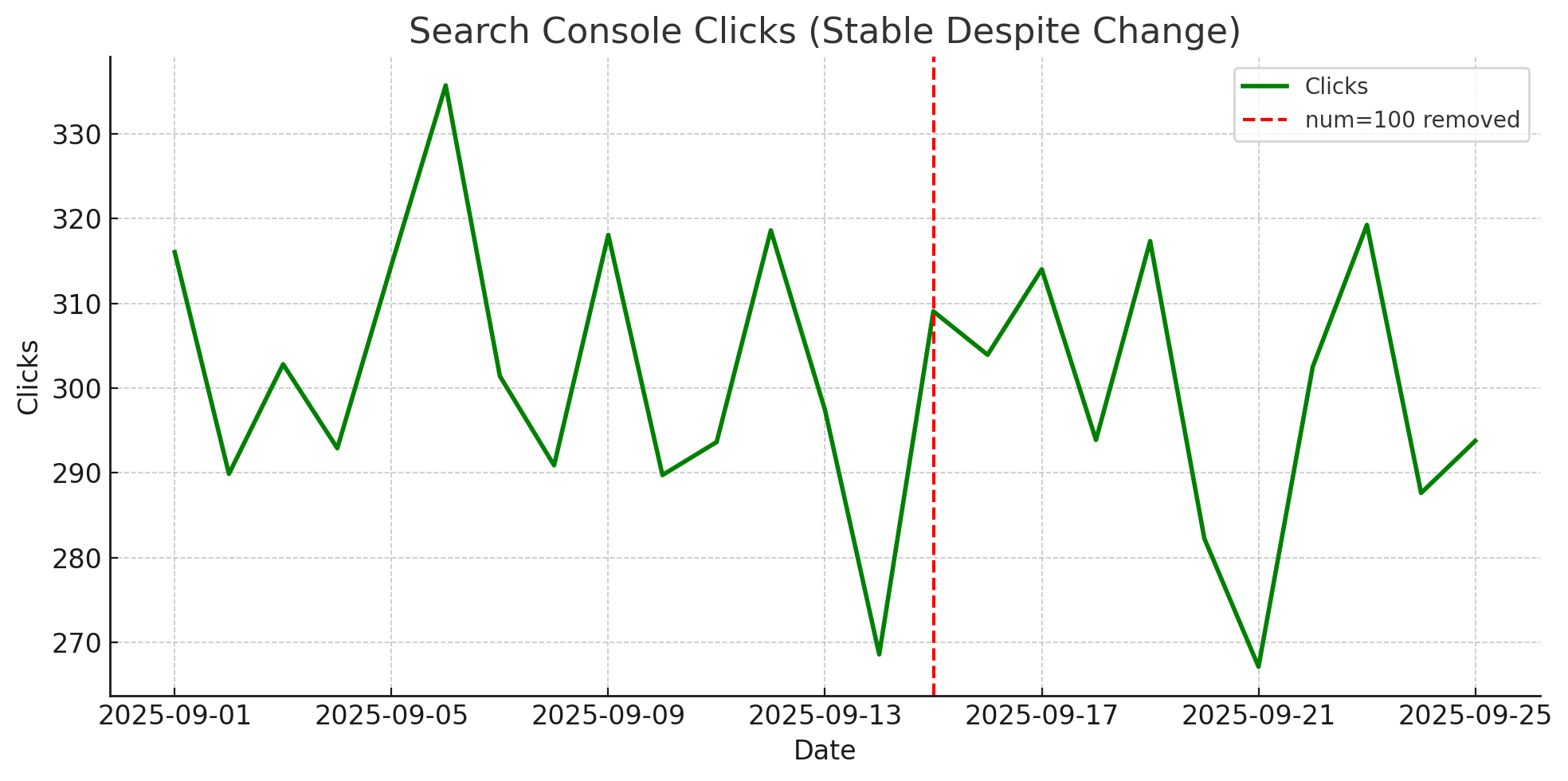If you’ve recently opened Google Search Console and seen a sudden, dramatic drop in impressions, you’re not alone. Across the SEO industry, marketers and tool providers have been reporting the same thing. The culprit? Google’s quiet removal of the num=100 parameter — a long-standing shortcut that allowed users (and SEO tools) to view 100 search results on a single page.
This change might look like bad news at first glance. But as with most Google updates, there’s more to the story. Here’s what’s happened, why it matters, and what you should do next.
What Was num=100?
For years, Google searchers could append num=100 to a search URL to load up to 100 organic results on one page, instead of the default 10.
For everyday users, it was a convenience feature. For SEO tools and rank trackers, it was a lifesaver: they could pull 100 results with one request, making scraping far more efficient.
Because it worked consistently for so long, many assumed it was a “supported” parameter — even though Google never formally endorsed it.
What Changed?
In mid-September 2025, SEOs noticed that num=100 no longer worked. Instead of showing 100 results, Google quietly defaulted back to its standard pagination.
Google later confirmed the change, saying that the parameter was “not something we support”. In other words: the shortcut was tolerated for years, but is now officially gone.
The Immediate Impact
1. Search Console Data Shifts
- Impressions fell off a cliff. Sites saw dramatic drops in reported impressions, particularly on desktop.
- Average position improved. With fewer bot-generated impressions from deep search pages, the “average position” metric shifted upwards for many sites.
- Traffic stayed stable. Crucially, for most websites, clicks and traffic did not decline. The drop was largely measurement noise disappearing.
2. SEO Tools Scramble
- Rank trackers and SERP scrapers that relied on
num=100suddenly had to fetch 10 pages of results instead of one. - This increased infrastructure and bandwidth costs for tool providers.
- Some tools temporarily limited the number of results shown (e.g. top 20 or top 50) until they adjusted.
3. Client Reporting Becomes Messy
- SEO reports suddenly looked worse: fewer impressions, lower visibility.
- Without explanation, clients might assume performance has tanked — when in reality, the data baseline has shifted.

Impression Amounts
This graph shows the impression numbers dramatically drop after the update to Google.

Amount of clicks
During the same time frame, the click amounts stay the same as 'bot' impressions never turned into clicks anyway.
Why Did Google Do This?
Google hasn’t given a detailed explanation, but several factors are likely at play:
- Scraping control: Blocking
num=100makes it harder for automated systems to harvest large chunks of SERP data in one go. - Infrastructure efficiency: Forcing pagination reduces strain on servers and ensures results are delivered in a way that reflects normal user behaviour.
- Cleaner data: Removing bot-driven impressions makes Search Console metrics more representative of real searcher behaviour.
- Strategic control: Limiting external data gathering keeps SEOs more reliant on Google’s own reporting tools.
How SEOs Should Adapt
1. Recalibrate Reporting
- Set new baselines for impressions and average position.
- Annotate client reports to flag the change and avoid panic.
- Focus on clicks, CTR, and conversions — metrics that reflect reality.
2. Check Your Tools
- Speak to your rank tracker provider. Ask how they’re adapting, and whether they’ll change result limits or pricing.
- Expect slower updates or temporary gaps in visibility as systems adjust.
3. Shift Your Strategy
- With deep SERP data harder to access, the emphasis is clearer than ever:
- Aim for top-page rankings.
- Prioritise quality content, technical excellence, and user experience.
- Don’t waste energy optimising for positions beyond page one — they’re less visible and now harder to measure accurately.
4. Educate Stakeholders
- Explain the update clearly: “This isn’t a traffic drop — it’s a reporting change.”
- Use visuals (before vs after graphs) to show that clicks remain stable.
- Position the update as an opportunity to refine focus on meaningful metrics.
Risks to Watch
- Tool pricing: Some providers may increase costs to cover extra processing.
- Volatile reports: Expect short-term data swings as systems adjust.
- Legacy scripts breaking: Any old automations relying on
num=100will need re-engineering.
Final Thoughts
Google’s removal of the num=100 parameter feels disruptive, but it’s not the catastrophe it first appears to be.
Yes, impressions will look lower. Yes, tools are scrambling. But the underlying truth is positive: we now have cleaner, more realistic data, less clouded by artificial bot-driven impressions.
Like Twitter a few years ago, removing fake bot followers led to some accounts losing hundreds or thousands of “followers”. But those followers were never real. What we are seeing in Search Console data now is a far more accurate reflection of how websites perform in search.
Just like follower counts became more trustworthy after Twitter’s bot purge, Search Console data is now closer to reflecting how real users interact with your site.
Quick Answer
If your impressions dropped sharply in September 2025, it’s almost certainly due to Google removing the num=100 parameter — not because your site suddenly lost visibility.
The real challenge for SEOs isn’t the loss of num=100 — it’s communicating the change clearly to clients, adapting reporting, and staying focused on what matters: visibility where it counts, traffic that converts, and strategies that stand the test of time.
Need help adjusting your SEO reporting or explaining these changes to stakeholders? Get in touch — we’d be happy to walk you through the new normal.
